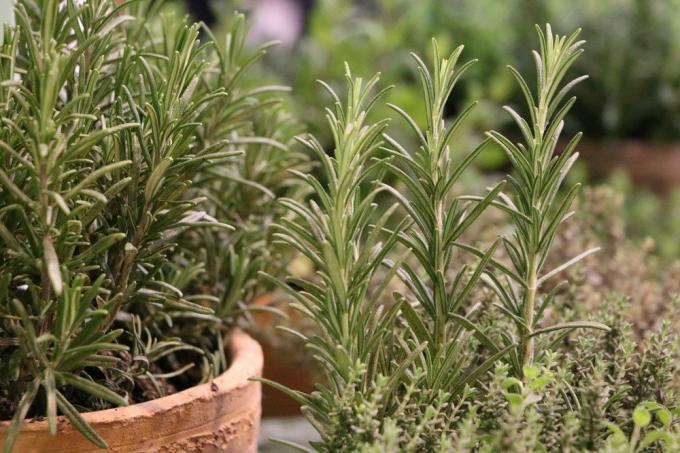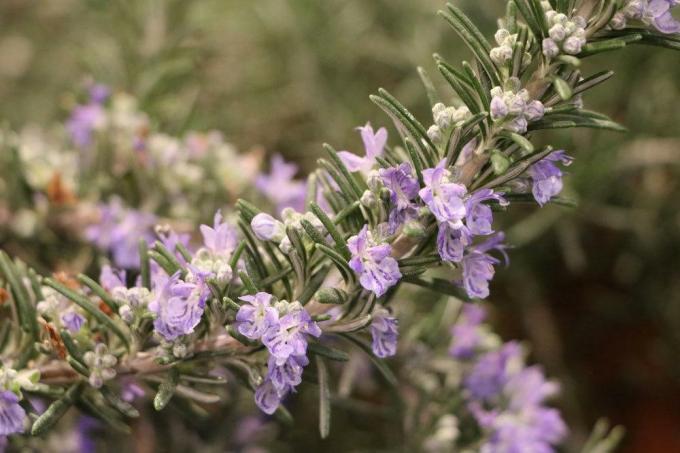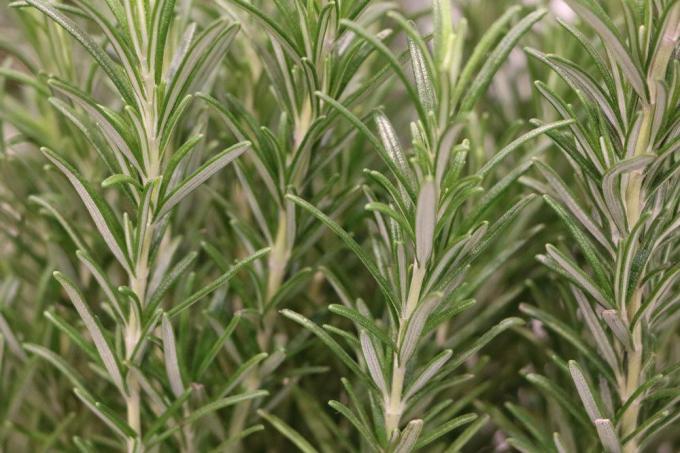
table of contents
- Winter in the house
- Cold protection
- Ventilation
- Frost damage
- to water
- Fertilize
- Cut
- After hibernation
The aromatic one rosemary is one of the most popular herbs. Its botanical name is Rosmarinus officinalis and it belongs to the mint family. The subshrub with the needle-like leaves is a Mediterranean plant. It is found predominantly in the Mediterranean area. Since the rosemary is used to a sunny and warm climate, you should prepare it for the cold winter. We explain here how best to do this.
Winter in the house
If a particularly cold winter has been announced, it makes sense to bring the rosemary into the house. This also applies if you live in a region that is highly prone to frost and where temperatures drop below -10 ° C. If you have already had the experience that the soil in your garden freezes right through to the roots, you should definitely overwinter the rosemary indoors. This is always recommended for non-hardy species and young plants - regardless of the region.
Location inside
If you want to overwinter your rosemary in a pot in your apartment or house, you should bring it to a suitable location. In addition to unheated rooms, hallways and stairwells, a cellar is also suitable under certain circumstances. The most important conditions for choosing a location are.
- cool
- 5 to 10 ° C are ideal
- Frost free
- bright
The brightness is important for the following reason: Rosemary is an evergreen plant and carries out photosynthesis even in the winter months. In order for this to run smoothly, rosemary needs a lot of light all year round.

Location outside
Under certain circumstances, you can also place your rosemary in the pot on the terrace or balcony. In this case, you should pay attention to these points.
- Roots do not rot
- Roots do not freeze
- Earth does not freeze over completely
- lignified branches do not freeze
Constant location
When overwintering in a pot, it is very important that the location remains the same over the winter. This means that the pot is not brought in from the outside - or vice versa. Changing the environmental conditions would damage the rosemary. If your plant has been on the balcony for the first few weeks and you would still like to bring it indoors, you can do that as an exception. However, you should not change it again in this case. In the house, the rosemary gets used to the higher temperatures. This means that it is no longer so hardy. The more constant the location, the better.
Cold protection
Cold protection for the pot
In order for your rosemary to survive the winter on the balcony or terrace, the pot needs protection against the cold. It is helpful to place the vessel on a styrofoam plate. In this way you can prevent the rosemary from being overcooled and the bottom of the pot freezing to the ground. Another positive effect is that the plant is protected from moisture from below. In addition, you can protect the plant in the pot with the following measures.
- Put leaves on the ground
- put some mulch on the soil
- Cover the earth with sticks
It is important that the air is still permeable. The protective layer must not be placed too tightly on the ground or even pressed into place. To prevent the parts of the plant above the ground from freezing, you can cover the entire plant. However, it must also be ensured here that this protection is air-permeable.

For example:
- Jute covers
- Hoods made of synthetic fleece
- small mats made of bamboo
- Coconut covers
Ventilation
If the rosemary is in the pot under a cover, you should help to ensure good ventilation. This also applies if the hoods are naturally air-permeable. The covers should be removed on frost-free days. But do not forget to put them back on the plant in good time so that it is not surprised by the next frost.
Frost damage
Examine for frost damage
Ventilation on frost-free days is a good opportunity to inspect the rosemary for damage. In this way, you can initiate appropriate measures in good time if necessary. You should improve the protection against the cold or, if necessary, change your location. However, frost damage is almost the only risk, as pests are very rare in winter.
to water
During hibernation, the rosemary needs very little water. You should therefore rarely water it. However, it is important that it does not dry out completely. It is ideal if you water just enough to prevent the rosemary from drying out. Due to its origin, the Mediterranean plant can usually cope with drought rather than wet. You should pay attention to this when watering in winter.
- no waterlogging
- a little more in strong sunlight
- on the terrace and balcony only on frost-free days
Tip: Do not forget to also water the rosemary under the protective hood on the balcony or terrace.

This is how you avoid waterlogging
Since rosemary is very sensitive if it gets too much water or waterlogging, you should prevent this. Only water when the soil feels dry. This is best felt with your fingertips. Make sure that excess water can always easily drain away. You can use a pot with holes and place it on a coaster. The water can collect there. Remember to periodically remove the accumulated water. If your rosemary is outdoors, you should leave out the coaster. In the event of heavy rain, too much water would collect and stagnate on it.
Fertilize
The rosemary must not be fertilized during the winter. A dose of additional nutrients would make the Mediterranean plant more sensitive. That would harm him in the cold season and should be avoided.
Cut
You don't need to cut the rosemary before or during winter. Then he needs all his strength to hibernate. A pruning of the Mediterranean plant is not recommended until spring. You can cut the rosemary back to 4 or 8 inches above the ground. In most cases it sprouts quickly.

After hibernation
When the winter months and the danger of frost are over, you can remove the protective cover from the rosemary. It makes sense to only remove the cover for a few hours at first. In this way, the rosemary can slowly get used to the new ambient conditions and temperatures. If you have covered the soil in the pot with leaves or mulch, this protective layer can now be removed. This also applies to coconut mats or styrofoam sheets.
